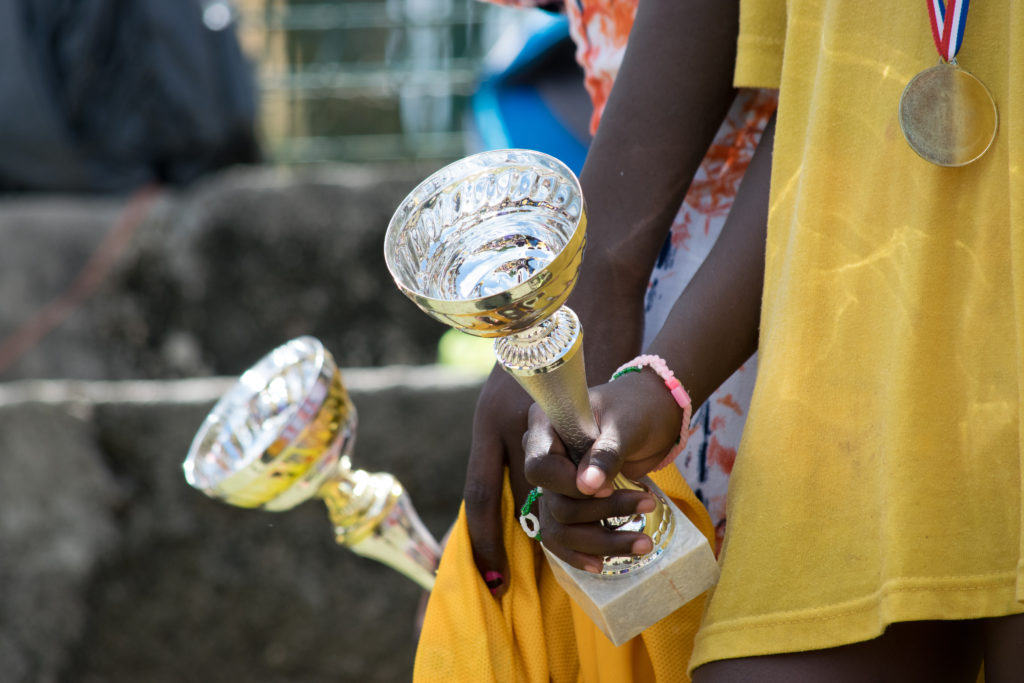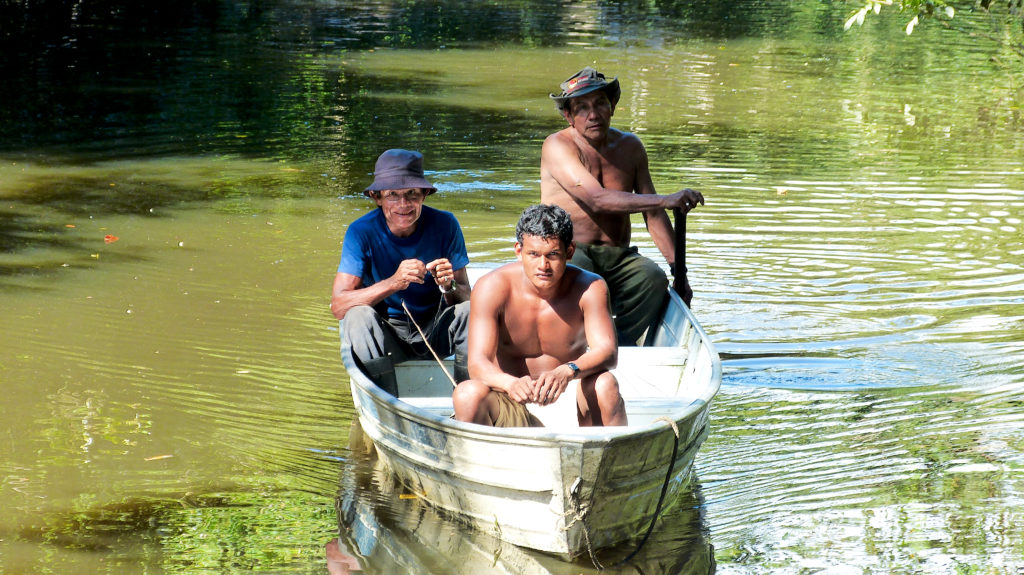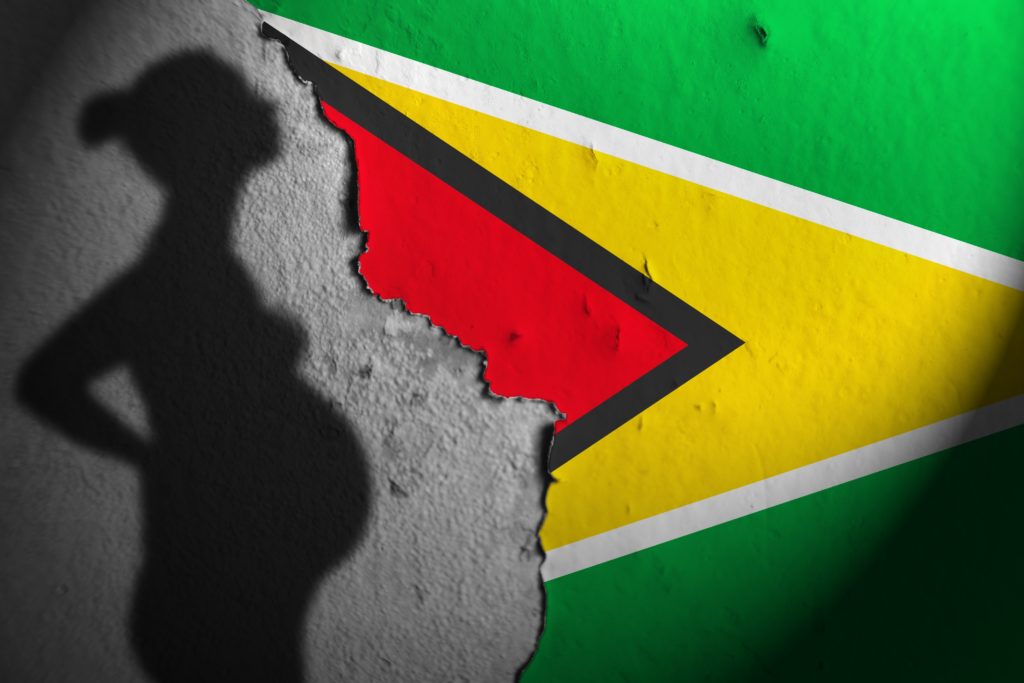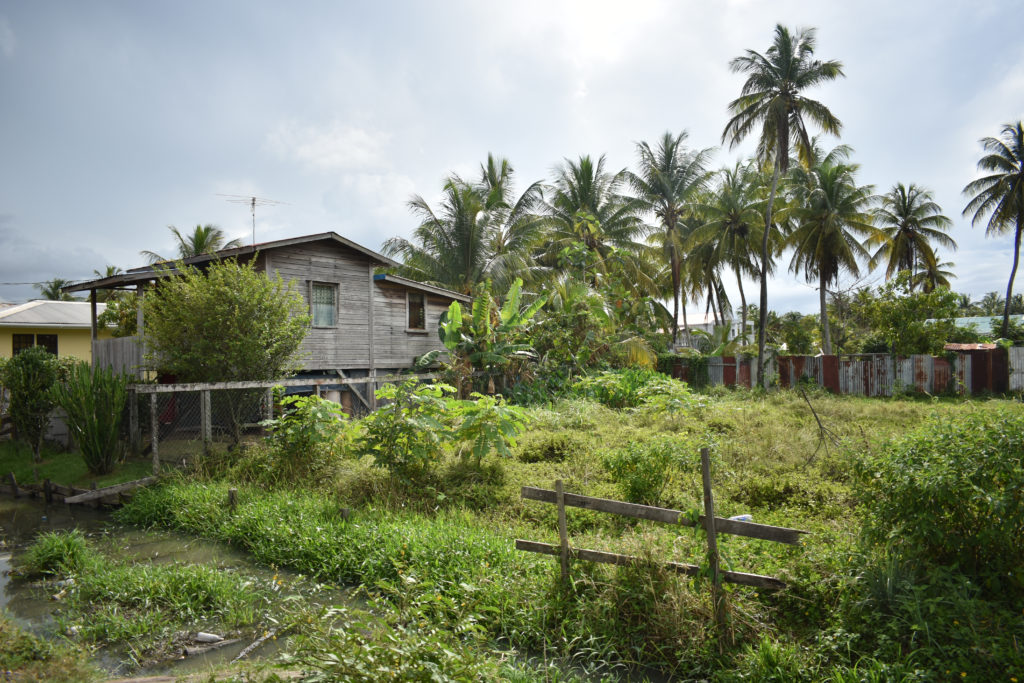Realizing Children’s Rights in Guyana


Children in Guyana face several key challenges impeding the realization of their human rights. Due to their geographic position, the catalytic effects of climate change and natural disasters present numerous challenges. Most pressingly, children are at risk of being subjected to the worst forms of child labour, corporal punishment, juvenile justice, violence against children and high adolescent pregnancy additionally endanger them.

Children’s Rights Index: 6,73/10
Red level: Difficult situation
Population: 786,599
Population ages 0-14: 27%
Life expectancy: 69.91 years
Under-5 mortality rate: 28.4‰
Guyana at a glance
Co-operative Republic of Guyana, as it’s officially known, is a small country located on the north-eastern corner of South America. It is bordered by the Atlantic Ocean to the north, Suriname to the east, Brazil to the south-west and Venezuela to the west. Georgetown is its capital and largest city, situated on the Atlantic coast and is nicknamed, “The Garden City of the Caribbean.” Guiana, “land of water,” is the country’s original name, given by the Indigenous peoples who were its original inhabitants. Guyana is the only English-speaking country in South America (Menke, 2022).
The natural environment of Guyana is varied, ranging from coastal plains and interior swamps to mountains and rivers. There are four main rivers located in the country: the Courantyne, Berbice, Demerara and Essequibo all of which flow into the Atlantic Ocean. Guyana also features an abundance of plant and animal life, including mangroves, saltwater grasses, diverse birdlife, ocelots, monkeys, sloths, bush pigs, armadillos, tapir, jaguars, manatees and iguanas (Menke, 2022).
Approximately one tenth of the population in Guyana are Indigenous groups, living either in coastal, interior regions or to the west, along the border with Venezuela and Brazil. The coastal Indigenous peoples are known as the Warao, the Arawak, and the Carib. The interior Indigenous peoples are known as the Wapisiana, the Arekuna and the Macusi.
The Wapisiana and Macusi Indigenous peoples predominately live in the Rupununi Savanna region. The remainder of the population are made up of Indo-Guyanese, making up two-fifths of the population (Guyanese of South Asian descent); Afro-Guyanese, accounting for three-tenths of the population (Guyanese of African descent) and people of mixed ancestry, accounting for one-fifth of the population (Menke, 2022).
Status of children’s rights [1]
Guyana has committed to several international instruments for the protection of children’s rights. In 1991, Guyana ratified the United Nations Convention on the Rights of the Child (UN CRC). However, the UN CRC is not enforceable under Guyanese law (CRIN, 2013). In 2010, the government ratified the Optional Protocol on the sale of children, child prostitution and child pornography and the Optional Protocol on the involvement of children in armed conflict.
Guyana is also party to other international human rights instruments including the Convention on the Elimination of All Forms of Discrimination against Women which was ratified in 1980, the International Convention on the Elimination of All Forms of Racial Discrimination in 1977, and the Convention against Torture and Other Cruel Inhuman or Degrading Treatment or Punishment in 1988.
Although Guyana does not have a consolidated Children’s Act, there are several pieces of national legislation that are of relevance to children. For example, this includes legislation such as, but is not limited to, the Status of Children Act No. 19 of 2009, the Childcare and Protection Agency Act No. 2 of 2009, the Protection of Children Act No. 17 of 2009, the Adoption of Children Act No. 16 of 2005 and the Sexual Offences Act No. 7 of 2010 (CRIN, 2013).
Regionally, Guyana is a member of the Organization of American States (OAS) and is bound to the Inter-American System of Human Rights. In 1996, the government ratified the Inter-American Convention on the Prevention, Punishment, and Eradication of Violence against Women (known as the Belém do Pará Convention). Guyana is also a member of the UN Economic Commission for Latin America and the Caribbean (ECLAC) and in 2013, the government adopted the Montevideo Consensus on Population and Development.
Addressing the needs of children in Guyana
Right to education
In Guyana, under the Ministry of Education, the Education Act 1876 (as amended in 1976), is the main regulatory framework governing education from primary level through to the tertiary level. The education system comprises of nursery (pre-school), primary, secondary, technical and vocational education and university (UNESCO, 2007). Nursery education is for children aged between three and six, although it is not compulsory. Primary education is compulsory and begins from the age of five up until the age of eleven. During the final year of primary school, children are required to undertake the Secondary School Entrance Examination (SSEE) in order to progress onto secondary school.

Students who receive high academic achievement in the SSEE are rewarded by attending the President’s College, and students who score poorly attend community high schools which are tailored to prepare children for vocational skills. Students who successfully pass the SSEE transition into secondary schools where they complete five years of education. Secondary school prepares students to sit the Caribbean Examination Council ((CXC) (UNESCO, 2007).
Education in Guyana is compulsory for children between the ages of six and fifteen. However, across rural and interior areas of Guyana, due to poor infrastructure, inaccessibility of schools, lack of transport or high transport costs and a shortage of trained teachers, children have limited access to education (US Department of Labour, 2021). During the COVID-19 pandemic, the lack of information technology and reliable electricity across riverine and rural communities had an impact on children’s education (US Department of Labour, 2021).
Education in Guyana is primarily financed by the government. However, since the 1990s, private schools have been self-financing. Non-governmental organizations such as the Lions Club and Rotary finance schools for children with disabilities (UNESCO, 2007).
From 2022 up until 2027, the World Bank has invested $44 million USD into education in Guyana. This project, aimed at improving quality of education in grades seven to nine, will develop a new school curriculum to emphasize environmental stewardship and climate change. It will additionally finance new academic textbooks, increase teacher training, ensure mentorship of academic staff, support children with disabilities, as well as improve school facilities and infrastructure (World Bank, 2022).
Right to health
The Ministry of Health developed a National Strategy for Guyana 2012-2020, also known as the “Health Vision 2020.”. This strategy aimed to address key priorities in improving health outcomes in Guyana. For example, it addressed strengthening and promoting capacities for sexual and reproductive health, increasing the use of contraceptives, promoting screening for sexually transmitted diseases, and increasing services for sexual and reproductive health for people living with disabilities. Other targets for Health Vision 2020 included targeting communities and families to reduce maternal, infant and child mortality, continuum of health coverage, improve adolescent health care and access to rehabilitation services (UNICEF, 2018).
In Guyana, adolescents are less likely to visit health care centers out of fear of being judged or the lack of confidentiality. To encourage a behavioural change, in 1999, in collaboration with UNFPA, the government launched a pilot study on adolescent friendly health centers to promote adolescent sexual and reproductive health in Victory Valley, Beterverwagting and Port Mourant.
Initially the pilot study aimed to address adolescent pregnancy, HIV/AIDS, substance abuse, suicide, social and spiritual needs as well as adolescent counselling services. From 2000, with the support of UNICEF and the Center for Disease Control and Prevention (CDC), the government established nineteen adolescent-friendly health units across Guyana (UNICEF, 2018).
Right to clean water and sanitation
In 2018, the World Health Organization (WHO) estimated that 86% of the population in Guyana had access to basic sanitation. Between July 2014 and July 2019, the Inter-American Development Bank and the European Development Fund implemented a $29 million USA project in Guyana to improve the efficiency, quality and sustainability of potable water and sanitation services. This project benefited 328 households across Guyana, and it was able to deliver sanitation, water supply, hand hygiene, and water, sanitation and hygiene (WASH) solutions (Reyes, 2021).

In Guyana, water and sanitation utilities are provided by Guyana Water Inc (GWI). GWI operate the only sewerage system which caters to 2% of the population in Central Georgetown. The rest of the population disposes of wastewater through septic tanks (66%) and pit latrines (28%) (Reyes, 2021). Gold mining, poor waste disposal and pollution mean water quality in many locations is sub-par, placing the health and well-being of children at risk due to the prevalence of waterborne diseases (UNICEF, 2018).
Right to identity
All children born in Guyana must be registered at birth under Sections 18, 25 and 26 of the Registration of Births and Deaths Act (Chapter 44:01) of the Laws of Guyana. Children must be registered by their parents, regardless of their legal or marital status and birth registration is free. Registration takes place at the General Register Office, of which there are 200 centers across Guyana (UNHCR, n.d).
The General Register Office has undertaken several initiatives to increase birth registration in Guyana. These include the establishment of registration centers in rural areas in order to have home births registered and ensure that all children living in rural areas can be registered, training of registrars to ensure that they have the necessary skills to effectively register births and supporting Indigenous communities to ensure that all children possess a birth certificate. While children in Guyana do not need a birth certificate to access health care services, they need it for admittance to school (UNHCR, n.d).
Under The Constitution of Guyana 1980, all children born in Guyana are entitled to citizenship except in cases where: (1) neither parent is a citizen and one or both parents have been granted diplomatic immunity, (2) where one parent is an enemy alien, and the child is born under enemy occupation. For children born outside of Guyana, citizenship can be granted to them if either one of their parents are Guyanese nationals (Immigration and Refugee Board of Canada, 2008).
Risk factors 🡪 Country-specific challenges
Child labour
In 2021, the government made minimal advancements to eliminate the worst forms of child labour in Guyana. The government has ratified all key international conventions concerning child labour, such as the International Labour Organization (ILO) Minimum Age Convention (No. 138) 1973; the Worst Forms of Child Labour (No. 182) 1999; the Palermo Protocol on Trafficking in Persons. However, despite this, gaps still exist in the legal framework to adequately protect children from labour (US Department of Labour, 2021).
Children in Guyana are subjected to the worst forms of child labour, including commercial sexual exploitation as a result of human trafficking, predominately in Georgetown. They are also subjected to the worst forms of child labour within sectors such as agriculture, working in the production of cherries, limes, rice, cabbages, sugarcane and charcoal, as well as working in sawmills and raising chicken.
Within industry and domestic sectors, children are subjected to construction, gold and bauxite mining, domestic work, and working in bars, restaurants and iron scrap yards. It is estimated that 41% of Amerindian children are engaged in domestic work and 34% in hazardous work (US Department of Labour, 2021).
Under the Employment of Young Persons and Children Act, the minimum age for employment is fifteen years old. Guyana does not meet international standards on hazardous work for children because it allows children between the ages of sixteen and seventeen to undertake hazardous work, which jeopardizes their health and safety (US Department of Labour, 2021).
Since 2021, criminal law enforcement authorities have taken concrete measures to address child labour in Guyana, including the establishment of a National Steering Committee on Child Labour and a Ministerial Task Force on Trafficking in Persons. Key policies have also been introduced, such as the National Child Labour Policy and National Action Plan for the Elimination of Child Labour 2019-2025 and the Inter-Ministerial Task Force on Combatting Trafficking in Persons Action Plan 2021-2025 (US Department of Labour, 2021).
Through the establishment of these policies, criminal law enforcement agencies have been able to report fourteen violations of commercial sexual exploitation of young girls, nine reports of children in forced labour, fifteen survivors of exploitation, and fourteen cases of child trafficking of which eight survivors were under the age of eighteen (US Department of Labour, 2021).
Adolescent pregnancy

Regionally, Guyana has one of the highest rates of adolescent pregnancy with 66.5 out of every 1,000 adolescent girls giving birth annually. Over a 20-year period, between 1997 and 2016, one in five adolescent girls in Guyana gave birth. In 2013, with inspiration drawn from the “Safe Motherhood Initiative” in Kenya, the Guyanese government established adolescent pregnancy clinics and a “Safe Motherhood Initiative” launched by the Maternal and Child Health Department of the Ministry of Public Health.
In 2018, the Ministry of Public Health in collaboration with UNICEF, carried out a Situation Analysis on adolescent pregnancy in Guyana to prevent adolescent pregnancies, raise awareness, develop curriculum for sexual and reproductive education and enhance legal frameworks (UNICEF, 2018).
Despite these efforts, adolescent pregnancy rates in Guyana are high and can be attributed to a lack of comprehensive education on sexual and reproductive health, poverty, lack of access to contraceptives, engaging in risky and unprotected sexual behaviours and sexual violence and sexual abuse. Other factors including increased school drop-out rates, living in single-parent households as well as living in overcrowded homes further contribute to the issue (UNICEF, 2018).
Violence against children
Violence is prevalent in Guyana and affects children from all ethnicities, gender, socio-economic, urban and rural areas. However, children with disabilities and LGBTQ children are perceived as easy targets and are disproportionately reported as victims of violence. Additionally, in Guyana, physical abuse is generally viewed as an acceptable form of discipline (UNICEF, 2019).
Several factors drive violence against children in the country. These catalysts are typically tied to poverty, hunger, alcohol and drug abuse. As such, those in residential homes or from vulnerable communities and are most susceptible to abuse. Abuses tend to occur equally across different ethnicities and genders (UNICEF, 2019).
Corporal punishment
In Guyana, corporal punishment is lawful in the home, in alternative care settings, in day care, schools and penal institutions. In a school setting, corporal punishment is permitted under Section 9(A) of the Criminal Law (Offences) Act 1894, which reiterates “the right of the guardian or teacher of a child to administer reasonable and proper punishment of the child.” Corporal punishment is only to be administered by the head teacher, deputy head teacher, or a designated senior teacher for the offences of fighting and indecent language at school (End Violence Against Children, 2020).
The punishment varies for boys and girls. For boys, the punishment is to be administered on the hands or buttocks and for girls, on their hands. The punishment is only allowed to be inflicted with a cane or a strap that is no longer than 24 inches and must be recorded in a “misdemeanours book” (End Violence Against Children, 2020).
During its 2013 Concluding Observation, the Committee on the Rights of the Child urged the government to address and prohibit all issues relating to the corporal punishment of children in all contexts. The issue of corporal punishment in Guyana has also raised concerns with the Committee against Torture, the Human Rights Committee and the Committee on the Elimination of Discrimination Against Women. These Committees have urged the government to prohibit corporal punishment in all settings and encouraged the government to develop awareness-raising campaigns (End Violence Against Children, 2020).
Juvenile justice
Despite concerns raised and recommendations by the Committee on the Rights of the Child for the inhuman sentencing practices of children, youth in Guyana are still subjected to corporal punishment and inhuman sentencing. Under the Juvenile Offenders Act 1931, the minimum age of criminal responsibility in Guyana is ten and children can be subjected to adult penalties at the age of seventeen. Similarly, under this Act, a child is considered under the age of fourteen, a young person between fourteen and sixteen and a juvenile as under seventeen (CRIN, 2010).
For crimes such as murder and manslaughter, a child under the age of eighteen may be tried as an adult and if found guilty, be sentenced to life imprisonment. For boys aged seventeen and over, corporal punishment is viewed as an adequate sentencing measure while whipping of girls is strictly forbidden (CRIN, 2010).
Environmental challenges

Environmental degradation and climate change have a significant impact on children in Guyana. Some of the negative impacts of climate change on children in Guyana include filaria and malaria. These are caused due to flooding, which leaves stagnant pools of water that cause mosquitoes to breed larvae. During drought season, particularly in the interior parts of the country, water levels remain significantly low due to intense heat. These intense weather conditions impact children’s academic attendance and often, schools remain closed (UNICEF, 2018).
During periods of intense rainfall or dry spells, water resources are at risk of contamination due to poor sanitation and shallow wells. As a result of these extreme conditions, families in Guyana are pushed to relocate to safer areas (UNICEF, 2018). Climate change has also impacted children’s food security in the coastal and hinterland areas of Guyana. As a result of drought, crops such as cassava, which are a part of the staple diet for the Amerindians, are inadequate and scarce (UNICEF, 2018).
Climate change is also a catalyst for further issues for children. Natural disasters and inaccessible food, water, and energy sources force children to act as providers, leaving them less time to attend school. This is heightened where families need children to raise funds to support the home, due to climate-enforced challenges. Climatic changes and disasters such as floods can also force permanent displacement, pushing children into dangerous shelters with inadequate sanitation and increased risk of abuse (UNICEF, 2018).
Written by Vanessa Cezarita Cordeiro
Internally proofread by Aditi Partha
Last updated on 13 November 2022
References:
CRIN. (2013, February 13). “Guyana: national laws.” Retrieved from Child Rights International Network, accessed on 25 October 2022.
CRIN. (2010, December). “Inhuman sentencing of children in Guyana.” Retrieved from Child Rights International Network, accessed on 25 October 2022.
End Violence Against Children. (2020, June). “Corporal punishment of children in Guyana.” Retrieved from End Corporal Punishment, accessed on 25 October 2022.
Immigration and Refugee Board of Canada. (2008, August 25). “Guyana: Citizenship laws, including methods by which a person may obtain citizenship; whether dual citizenship is recognized and if so, how it is acquired; process for renouncing citizenship and related documentation; grounds for revoking citizenship.” Retrieved from Canada: Immigration and Refugee Board of Canada, accessed on 12 November 2022.
Menke, J.K., Richardson, B.C. (2022, October 18). “Guyana.” Retrieved from Encyclopaedia Britannica, accessed on 25 October 2022.
Reyes, M., & Ramjag, L. (2021, July 13). “Improving lives through adequate sanitation in Guyana.” Retrieved from Inter-American Development Bank, accessed on 12 November 2022.
UNICEF. (2019, June). “Study of social norms in Guyana as it pertains to sexual, physical and emotional violence against children.” Retrieved from UNICEF Guyana and Suriname, accessed on 26 October 2022.
UNICEF. (2018, December). “Situation analysis of adolescent pregnancy in Guyana.” Retrieved from UNICEF Guyana and Suriname, accessed on 26 October 2022.
UNICEF. (2018). “Climate landscape analysis for children: An assessment of the impact of climate, energy and environment on children in Guyana.” Retrieved from UNICEF Guyana and Suriname, accessed on 12 November 2022.
UNESCO. (2007). “Principles and general objectives of education in Guyana.” Retrieved from World Data on Education, accessed on 12 November 2022.
UNHCR. (n.d). “Birth registration legal framework.” Retrieved from Office of the United Nations High Commissioner for Human Rights, accessed 12 November 2022.
US Department of Labour. (2021). “2021 Findings on the Worst Forms of Child Labour.” Retrieved from U.S Department of Labour Bureau of International Labour Affairs, accessed on 26 October 2022.
World Bank. (2022, June 10). “Education in Guyana to be improved with US$44M World Bank Project.” Retrieved from The World Bank, accessed on 12 November 2022.
[1] This article by no means purports to give a full or representative account of children’s rights in Guyana: indeed, one of many challenges is the scant updated information on the children in Guyana, much of which is unreliable, not representative, outdated or simply non-existent.

